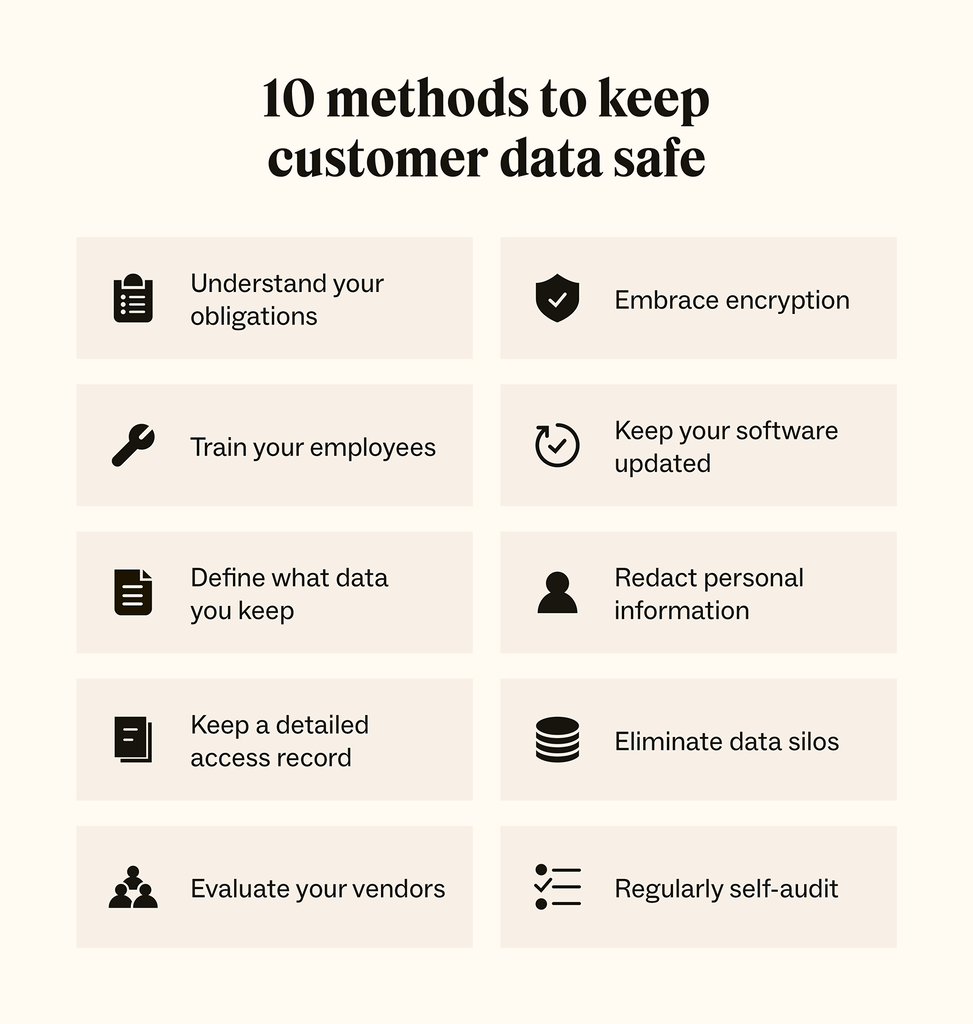Article • 1 min read
Customer data protection: 10 tips to keep information safe
Customer data protection helps protect you and your customers from cyberattacks, data leaks, and legal issues. Learn how to safeguard customer data in this guide.
โดย Hannah Wren, Staff Writer
อัปเดตล่าสุด May 15, 2024
What is customer data protection?
Customer data protection is a strategy businesses use to keep customer data safe from cybercriminals, internal negligence, and other breaches. This can involve network security, password protection, and data encryption procedures.
Personalization is no longer a nice to have—it’s an expectation. However, as businesses gather customer information to tailor experiences, they can be exposed to data leaks. According to the Zendesk Customer Experience Trends Report 2024, 77 percent of CX leaders see themselves as responsible for making sure customer data is safe.
Luckily, businesses can succeed in personalizing their customers’ experiences and keeping their information safe—the solution is to engage in proper customer data protection. In this guide, we cover why protecting customer privacy is critical and the 10 steps to follow to help keep your customer data safe.
More in this guide:
- Why is protecting customer data important?
- What types of customer data should you protect?
- How to protect customer data: 10 tips
- Dangers of poor consumer data protection
- Customer data protection regulations
- Frequently asked questions
- Keep your customer data safe with Zendesk
Why is protecting customer data important?
Protecting customer data is important for building seamless and trustworthy personalized customer experiences (CX). As the demand for AI-driven, personalized experiences increases, CX leaders are proactively acquiring new skills to protect data and enhance the customer journey.

For businesses, robust data protection can build trust with customers. Per our CX Trends Report, 70 percent of consumers won’t purchase from a company if they doubt its ability to protect their data. Brands that engage in proper customer data privacy and customer transparency can unlock the power of seamless, personalized experiences that foster customer loyalty. This can lead to a positive brand reputation and an improvement in your bottom line.
For customers, effective security measures lead to more personalized experiences. Personalization is important because it creates a custom experience—whether it entails tailored product suggestions based on purchase history or delivering proactive customer support. When businesses embrace data protection and feel confident gathering and using customer data, they can provide a better, highly personalized CX.
What types of customer data should you protect?
The short answer is that you should protect all customer data. But to get you started, here are some of the most common types of customer data:
- Personal Identifiable Information (PII): This information can directly identify a person’s identity. Some examples include names, addresses, phone numbers, and Social Security numbers.
- Personal Health Information (PHI): This includes data regarding a person’s medical status, like medical records, diagnoses, ongoing treatments, and insurance information.
- Financial information: This data includes credit card numbers, bank account details, and payment histories.
- Behavioral data: This is data about how a customer spends their time on the internet, such as the pages they visit, the purchases they make, and the content they interact with.
Be mindful that, depending on your industry, you may be exposed to other forms of data. No matter your business, managing customer data and keeping it safe should be a top priority.
How to protect customer data: 10 tips
Now that we’ve covered the why behind protecting customer data, we’ll delve into the how. Here are 10 tips to fortify your security measures.

1. Understand your obligations
The first step in protecting customer data is becoming an expert in the subject. Familiarize yourself with applicable data laws and regulations in your industry—a topic we outline below—and note where your customers are coming from.
For example, you might do most of your business with customers in the United States, but if you have some European clients, you should research European privacy laws to make sure you adhere to them. You may also need to be aware of industry-specific regulations, such as compliance with HIPAA if you’re in the healthcare industry.
2. Train your employees
Many data breaches are caused by some level of human error. This can be as simple as misplacing confidential passwords or responding to a phishing email from a cybercriminal pretending to be the CEO.
Given how easily data can be exposed, it’s crucial to conduct regular training sessions and exercises with your team to ensure they understand the importance of safeguarding customer data and the proper protocols for doing so
3. Define what data you keep
Many businesses today leverage customer analytics to guide marketing efforts and product improvements. While that’s important, having too much customer data is a problem. Cybercriminals target businesses with large archives of consumer information, so collecting more data than you need can make you a prime target.
Instead, take inventory of all the customer information your business stores and evaluate how well it’s serving your business needs. Keep what you need and delete what you don’t to limit your risk.
4. Limit data access and keep a detailed access record
Only certain employees need access to every piece of consumer data. For example, an employee on your customer service team may not require access to the same information that a member of your marketing team needs. Limiting customer data access to the select employees who need it is good practice.
You’ll also want to keep a detailed access record. This creates a log of who is viewing what kind of data and when—allowing you to ensure that your team is following best practices and that there isn’t any unauthorized access.
5. Evaluate your vendors
If one of your third-party vendors or your customer data platform (CDP) is involved in your data, you need to vet them. Do research to make sure they comply with relevant data protection regulations and are qualified to handle your sensitive information. Evaluate if they are certified in data protection, too.
Zendesk, for example, has several compliance certifications and memberships to keep your private data private.
6. Embrace encryption
Encryption is a security measure that obscures data so only authorized users can read it. If an unauthorized user were to access encrypted data, it would appear scrambled and unreadable—but when verified users access it, the data reverts to its normal state.
This technology is valuable in several situations, such as protecting a Wi-Fi network or using a password manager to store sensitive passwords. Encrypting data wherever possible adds an extra layer of security that can reduce the risk of data breaches.
7. Keep your software up to date
Constant software update notifications may seem annoying, but doing so is a cybersecurity best practice. These updates typically involve security patches and other modifications that make it harder for hackers to break into your system. Cybercriminals are always searching for businesses that don’t have up-to-date software—avoid becoming a prime target by keeping your software updated.
8. Redact personal information
There may be times when you need to store data or share a document with sensitive information. In these cases, redact customer or employee information that isn’t essential for the task at hand. For example, remove a customer’s Social Security number from a document that the marketing team needs to access. Regularly engaging in redaction can limit the exposure or misuse of sensitive data.
9. Eliminate data silos
Data silos happen when businesses store various data in separate locations—for example, having customer billing records in one system and purchase history in another. Break down these silos by implementing centralized locations where you can house all sensitive information and customer data visualizations. This unification helps to keep information secure and leads to better data practices. It also enables support teams to personalize customer interactions.
10. Regularly audit yourself
Finally, you’ll want to conduct regular internal audits to ensure your protection processes are continuously up to snuff. These internal security audits include penetration tests and vulnerability scans, which can help you judge your security status. By proactively addressing your security, you can address your internal weaknesses and mitigate exposure risk.
Dangers of poor consumer data protection
As we’ve touched on, poor consumer data protection can lead to massive problems for businesses and consumers. Businesses must balance data privacy and personalization to give consumers excellent experiences while keeping their information safe—meaning data security is paramount.
Sub-par security can lead to issues like:
- Identity theft: If PII is compromised, cybercriminals can easily use that information to commit identity theft, engage in phishing scams, and perform other damaging actions.
- Legal issues: If a business is determined to be at fault in the aftermath of a data breach, it can face several legal repercussions and compliance violations.
- Financial penalties: Customers can experience falsified accounts opened in their name and unauthorized financial withdrawals, while businesses can be liable for these damages and more.
- Reputation loss: Businesses that experience notable data breaches tend to have difficulty repairing their reputation and getting customers to trust them again.
These consequences are just the tip of the iceberg of what can happen after data breaches.
Keep an eye on the customer service horizon
Data security isn’t the only thing to prioritize this year. Check out the Zendesk Customer Experience Trends Report 2024 to learn about the most important trends.
Customer data protection regulations
The United States doesn’t have a singular all-encompassing law regulating consumer data. These regulations are divided by industry or location. Here are some of the most common:
- Health Insurance Portability and Accountability Act (HIPAA): This establishes standards of security and privacy for health data in the United States. This only regulates communication between the patient and the health institution.
- California Consumer Privacy Act (CCPA): This act gives California citizens rights over their data and requires businesses to disclose data collection in the state.
- Fair Credit Reporting Act (FCRA): This regulates who can see, access, and store credit information.
- Family Educational Rights and Privacy Act (FERPA): This helps protect student records.
- General Data Protection Regulation (GDPR): This regulation establishes rules regarding collecting, processing, and storing personal data of European Union citizens.
It would be wise to research applicable regulations for your location and industry to ensure you comply with those that directly affect you.
Frequently asked questions
Keep your customer data safe with Zendesk
Customer data protection can be intimidating, but with the right CX software, it doesn’t have to be. At Zendesk, we offer advanced customer data privacy protection that can help you with access records, redaction, data masking, encryption, and more. This enables you to strengthen security measures while fostering tailored customer experiences that improve your bottom line and build trust.
